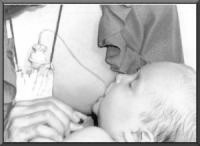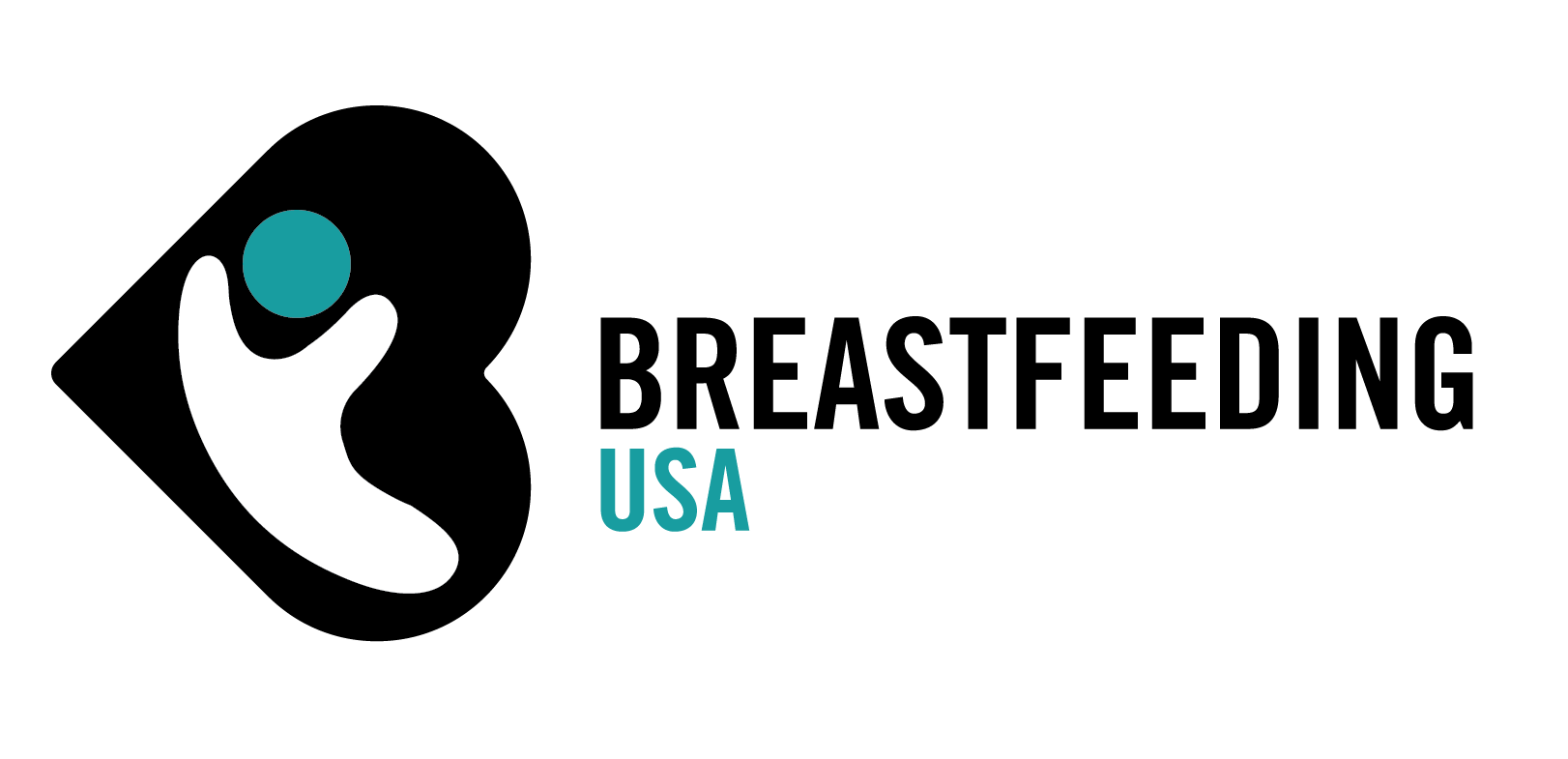By Lauren Fruehan, IBCLC, RLC

What is an At-Breast Supplementer?
In a society where bottles are seen as an image of infancy, many people are surprised to learn there are other ways to provide supplements to a breastfed baby. One such method is the at-breast supplementer. An at-breast supplementer is a device that allows a supplement to be given while a baby is actively nursing at the breast. This is sometimes referred to as a supplemental nursing system, or SNS, but SNS is actually a term for which Medela has the trademark. While there are many types and brands of at-breast supplementers, the basic concept is the same. Each consists of some form of container with a tube attached. The tube is then placed next to your nipple, and when the baby latches to the breast, the tube and the nipple will both be in the baby’s mouth. The supplement travels from the container through the tube as the baby sucks, and the baby receives this supplement, along with directly suckled milk. The supplement inside the container can be your own pumped milk, human milk from a human milk bank, human milk obtained through milk sharing, infant formula, or any other appropriate supplement.
When Should an At-Breast Supplementer be Used?
A supplementer can be a useful tool if a supplement becomes necessary. It can be used in short-term situations, such as supplementing temporarily for jaundice, weight gain issues, or other infant health conditions. Babies with tongue or lip ties affecting transfer may benefit from the use of an at-breast supplementer until such ties can be corrected. An at-breast supplementer may be useful when nursing may not have gotten off to the best start, such as after a difficult birth where you and your baby may have been separated for some time. It may also be used temporarily in infants who are premature and unable to suckle strongly, so that they receive more milk for their suckling efforts.
At-breast supplementers can also be useful in the long term. If you have low milk production due to previous breast surgery or insufficient glandular tissue (IGT), you may find it gives you the opportunity to provide all feedings at the breast. In these situations you may feel that this allows you to have a more “normal” breastfeeding relationship, even if you cannot provide all of the milk your baby needs. An at-breast supplementer may also be used by if you have already weaned and wish to relactate, as it can be used to provide the necessary nutrition until your milk production can be re-established . Similarly, those wishing to breastfeed an adopted child may use one while inducing lactation, or simply to experience an at-breast relationship even if not able to produce their own milk.
Advantages and Disadvantages of Use
The following are just some of the advantages and disadvantages of using an at-breast supplementer, as adapted from the Core Curriculum for Lactation Consultant Practice and the experiences of many lactation professionals.
Advantages:
Avoids the use of artificial nipples
May increase milk production
Preserves the breastfeeding relationship
Increases the flow rate which may encourage some babies to stay at the breast longer
May help infant to improve their sucking pattern
Aids in learning by doing
Disadvantages:
May be complex to learn and cause frustration
May seem more intrusive and unfamiliar than other methods
Supplies may not be widely available
Cost may be a factor
The infant may prefer the faster flow of the at-breast supplementer because they get more milk more quickly
Can be time consuming to clean after using
Possible reluctance to nurse in front of others while using it
Since this device may have a steeper learning curve (but possibly greater rewards) than other devices, seek support and care when using it from a lactation professional who has hands-on experience assisting with at-breast supplementers. Look for someone with experience who can offer practical suggestions to reduce the learning curve. She can help to determine if an at-breast supplementer is a possible solution for your situation, and help you to use it correctly (including making sure the flow rate is appropriate for your baby). She can also help you to wean from the supplement and the at-breast supplementer when or if it is no longer needed. Some people need to continue using these devices for long periods of time.
Types of At-Breast Supplementers
There are a few types and brands available for at-breast supplementation. Brand preference may depend on cost, personal breastfeeding goals, what is available in the area, and nursing style. While there are a few at-breast supplementers meant for short-term supplementation, such as the Medela Starter SNS and Hygeia Transitional Feeder, there are three main at-breast supplementers. These are the Medela Supplemental Nursing System, the Lact-Aid Nursing Training System, and a homemade at-breast supplementer. The Medela SNS consists of a hard, reusable container with (three sets of) two tubes (which come in different diameters). The Lact-Aid is made of a disposable bag with one tube. According to Dr. Jack Newman, “A lactation aid consists of a container for the supplement—usually a feeding bottle with an enlarged nipple hole—and a long, thin tube leading from this container.”
The chart below is a brief comparison of the pros and cons of these three at-breast supplementers. Always follow the manufacturers’ instructions.
| Brand | Pros | Cons |
|---|---|---|
| Medela SNS |
|
|
| Lact-Aid |
|
|
| Homemade At-Breast Supplementer |
|
|
Tips, Tricks, and Advice
As mentioned above, an at-breast supplementer can be difficult to master. The following is a compilation of tips from mothers who have used them.
- Powdered formula can clog tubing.
- Babies with weak sucks or low tone or anatomical issues that prevent a good seal and normal suck may not be able to create vacuum to make tube work properly.
- “My best advice is to dial down the pressure and give yourself a lot of time to learn how to use it. No one gets it overnight. It takes a few weeks for mama and baby to both get the hang of it. But once you do, it’s smooth sailing.”—Bekki Hill
- “Give it time. It takes a few days to figure it out and longer to feel comfortable. That is okay.”—Rita Ditch
- “Keep at it. Don’t stress over it and keep trying. You’ll get it eventually.”—Evey Quines
- “Try all the different size tubes to find what works best for you and baby.”—Natasha Dooley
- “You will cry; baby will cry. In neither case will it mean long-term traumatization. You will both bounce back! In the end, you will feel like a superhero and so proud that you both mastered this skill because it means you can keep nursing for as long as you darn well please, and you made that happen. In practical terms, I would say start out with taping the tube to your breast in the right place (my LC said anywhere from the middle of baby’s lip to slightly to the side — but not right in the corner). Once you are both better at latching on with the tube (i.e. after weeks of practice), you can try doing it without the tape.”—Alison Masemann
- “I have used the homemade at-breast supplementer for 14+ months now. I use a solid cap with a hole in it (instead of a nipple), and then I put an elastic hair band over the tube and cap, to keep the end of the tube from sliding up and out of the milk. It can also be used to catch the end when not in use, so that milk doesn’t leak out. That is my ‘hack.’ The extra length 36″ tubing really makes it MUCH easier.”—Angie Kochukudy
- “I used an SNS for several months. I ditched the tape and the shoelace/string, and I just set the bottle part between my wide set breasts (thanks IGT!) supported by my sports bra. I just held the tube with my hand while he latched. The tape was a headache for me; we did better without.”—Helen Stewart
- “Stopping the tape made the whole process SO much easier. My skin was raw, and switching breasts was a huge pain until we went tape-free.”—Erica Goehhring
- “Instead of using the tape, use a Bandaid. Once you know where the tape should go, replace it with a Bandaid, and do not remove it between feedings. The tube can be threaded under the pad of the Bandaid.” –Norma Ritter
As a mother who personally used an at-breast supplementer for over 18 months, my advice is that if one style of at-breast supplementer doesn’t seem to work for you, try another. If the tape is a pain, do without. You can use the neck strap or ditch it.
The most important thing is to have support. Seek out a Breastfeeding USA Counselor or lactation professional with experience with supplementers. She can help you to evaluate your needs and show you how to use whatever device you choose. She can also provide ongoing support, if needed. It may be helpful for other family members to understand how the supplementer system works so that they can assist you, if necessary.
Conclusion
An at-breast supplementer is a tool that can be used if supplementation is necessary, but it may not be the best choice for every mother or situation. Working with a breastfeeding counselor or lactation professional, as well as talking with others who have used these devices, can help you to determine if an at-the breast supplementer is right for your situation. The supplementer may take time and patience to learn to use, but for many, the advantages are well worth it.
For more information on at-breast supplementers, see:
Lactation Aid from Dr. Jack Newman
Inserting a Lactation Aid Video from Dr. Newman of inserting and using a lactation aid
LowMilkSupply.org’s page on at-breast supplementers
Digging Into the Breastfeeding Toolbox from Hygeia
Diary of a Lactation Failure A blog with many entries on the use of at-breast supplementers
References
Hughes, V. (2013). Breastfeeding Devices and Equipment. In R. Mannel, P. J. Martens, & M. Walker (Eds.), Core Curriculum for Lactation Consultant Practice (pp. 643-714). Burlington, MA: Jones & Bartlett Learning, LLC.
Newman, J. & Pittman, T. (2006). The Ultimate Breastfeeding Book of Answers: The Most Comprehensive Problem-solving Guide to Breastfeeding from the Foremost Expert in North America. New York: Three Rivers
Lauren Fruehan, IBCLC, RLC
© Breastfeeding USA 2016, all rights are reserved.
